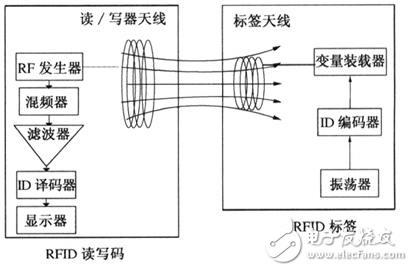Radio Frequency Identification (RFID) is a non-contact automatic identification technology realized by radio frequency communication. It can work in a variety of harsh environments, and can quickly identify multiple high-speed moving objects through labels attached to objects. Due to its rapid identification, RFID technology is increasingly favored by major manufacturers. It has great application potential in the fields of warehousing logistics, product anti-counterfeiting, product circulation and product maintenance tracking. The article analyzes the basic principles of RFID technology and introduces its applications in supply chain management, security and identity, and mobile tracking. RFID technology also faces many challenges and needs further study.
0 PrefaceIn recent years, radio frequency identification (RFID) technology has gradually become a mainstream application technology that enables rapid item identification. Unlike early bar code recognition technology, RFID technology does not require close-range use of the code reader, and can realize long-distance recognition through radio frequency signals. RFID tags can also identify various information such as product manufacturers, product types, and environmental variables as identities without having to use zebra-line labels like barcodes. In addition, the RFID system automatically recognizes RFID tags from different directions, greatly increasing the recognition rate compared to bar code recognition.
Although RFID has shown great advantages at the beginning of its birth, its high cost has hindered its commercial application. With the advancement of the electronics industry, the integration and miniaturization of electronic devices, the cost of RFID devices has been gradually reduced, thus enabling it to compete with traditional bar-shaped labels. In some large commercial locations, the advantage of RFID for commodity regulation is unmatched by common identification techniques.
1, RFID principleRFID is a non-contact automatic identification technology that uses RF signals to automatically identify target objects through inductive or electromagnetic coupling and acquire relevant data. Tags are a key part of RFID technology. The RFID tag contains a transponder that can send specific signals to the RFID reader. Most RFID tags have an ID serial number (such as a SKU code). After receiving the ID number, the reader can retrieve the relevant data from the database and follow the instructions. The RFID tag can also have a readable and writable memory for storing information sent to different readers for identifying the tagged object. The principle of the RFID system is shown in Figure 1.

RFID tags are classified into active tags and passive tags depending on whether they are active or not. Active RFID tags come with a power supply (such as an on-board battery), and passive tag energy is obtained by an electromagnetic reader through a reader. Similarly, the reader is also divided into an active reader and a passive reader depending on the type of tag being read.
1.1 Active label
The active tag has its own battery for power supply and is readable and writable. Thanks to its own power supply, active tags can transmit stronger signals and thus have longer read and write distances. However, on-board power supplies can make the tag size larger and more expensive, so active RFID systems are generally used for long-distance identification of large aviation tools as well as ordinary vehicles. Low-power active tags are usually slightly larger than a pair of poker. The active tag can be in a sleep state when the object does not enter the recognition distance. It is also possible to broadcast the signal continuously in the broadcast state.
Active tags can operate at higher frequencies, such as 455MHz, 2.45GHz, and 5.8GHz, depending on the actual identification distance and memory requirements. At these frequencies, the reader can operate in the range of 20m to 100m.
1.2 Passive label
The passive tag has no battery inside and gets the energy needed for the work from the magnetic field generated by the reader. When the tag enters the recognition range of the reader, the tag senses the electromagnetic field change through the antenna, and the induced current is generated by the electromagnetic induction, and the tag stores the generated energy through the integrated capacitor. When the capacitor accumulates enough charge, the RFID tag can use the energy provided by the capacitor to send a modulated signal with the tag ID information to the reader. Since the passive tag itself does not have a power supply, it is much lower than the active tag. In the United States, a tag typically costs about 20 cents. With the advancement of microelectronics technology, labels can be made smaller and cheaper. Due to its price advantage, it has a wider range of applications than active tags.
In addition to low prices, passive tags are still very small. However, current antenna technology limits the size of the tag, and the larger the tag, the farther it is to recognize the distance. At present, passive tags generally have only about 2K of memory. Due to limited memory, in addition to storing ID information and some historical information, it is not possible to store particularly complex and useful information, thus limiting its application to a certain extent. As RFID technology continues to advance, the amount of information that tags can store will continue to increase, allowing for the storage of more complex information.
The ID information of the communication between the passive tag and the reader is generally implemented by high frequency and low frequency modulation. In the low-frequency modulation mode (below 100MHz), the tag capacitor is matched with the inductor coil, and the signal strength is changed according to the tag ID information, and radiated outward. The speed of the change is affected by the modulation frequency. In the high frequency (above 100MHz) mode, the tag transmits the signal using backscattering, which makes the antenna variable impedance under the influence of the internal circuit. When the impedance changes, the antenna radiates the RF signal, and the reader can acquire and demodulate the signal. The passive tag operating frequency is generally 128 kHz, 13.6 MHz, 915 MHz, and 2.45 GHz, etc., and the recognition distance is thus ranging from several tens of cm to several m. The selection of system frequency is generally determined by environmental factors, transmission media, and identification range requirements.
2, RFID applicationIn recent years, with the maturity of RFID technology, its application range has become more and more extensive and has had far-reaching effects. The most widely used applications include supply chain management, security, and tracking of important things and people.
2.1 Supply Chain Management
This 80 -port USB charger: This 80 port USB charging station can quickly synchronize 80 devices to charge. This USB charging station multi -terminal charger can meet the needs of multiple people. Safe multi -end mouth charger center: This high -power fast charger has a solid aluminum metal frame to make the product long -term durable, built -in intelligent multiple security protection, can be used for over current, overvoltage, short circuit, etc. Hospital, ETC, etc.

80 Port Usb Charger,80 Port Mobile Charger,Multiple Usb Charging Station,Usb Charging Station Multiports
shenzhen ns-idae technology co.,ltd , https://www.szbestchargers.com